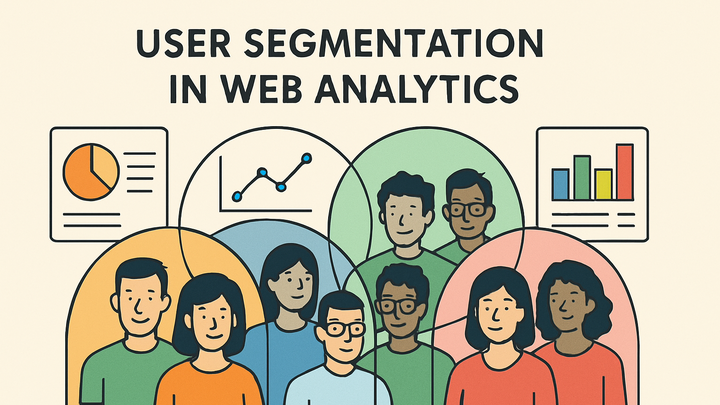Published on 2025-06-28T07:35:31Z
What is User Segmentation? Examples in Analytics
User segmentation is the process of dividing a user base into distinct groups based on shared characteristics or behaviors. In analytics, segmentation helps reveal patterns that might be hidden when looking at aggregate data. By categorizing users, businesses can tailor marketing, product development, and customer support to specific audience needs. Common segmentation criteria include demographics, behavior, location, and technology usage. Advanced analytics platforms enable dynamic segmentation, allowing real-time analysis and personalization. Implementing effective segmentation requires choosing meaningful criteria, ensuring data quality, and continuously refining segments based on performance insights.
User segmentation
Dividing users into distinct groups based on shared characteristics to improve targeting, personalization, and analysis in analytics.
Why User Segmentation Matters
User segmentation allows businesses to move beyond one-size-fits-all strategies by identifying and targeting specific user groups. It enhances marketing effectiveness, increases engagement, and optimizes resource allocation. Segmented insights reveal hidden trends and behavior patterns that aggregate metrics overlook. By personalizing experiences, companies can improve customer satisfaction and loyalty. Furthermore, segmentation supports data-driven decision-making by focusing analysis on the most relevant user cohorts.
-
Improved targeting
By segmenting users based on shared attributes, marketers can tailor content and offers to specific groups, increasing relevance and engagement.
-
Personalized experiences
Delivering customized messages and product recommendations to each segment fosters stronger connections and drives conversions.
-
Enhanced retention
Understanding which segments churn or stay helps businesses implement targeted retention campaigns and improve user lifetime value.
-
Deeper insights
Segmentation uncovers hidden patterns and correlations, enabling teams to test hypotheses and refine marketing or product strategies.
Types of User Segmentation
There are several common approaches to segmenting users in analytics, each based on different criteria and data sources:
-
Demographic segmentation
Groups users by demographic attributes such as age, gender, income, and education level.
-
Age groups
Segmenting users into age brackets (e.g., 18-24, 25-34) to understand preferences.
-
Gender
Separating users by gender to identify gender-specific behavior patterns.
-
Income brackets
Classifying users by income levels to gauge purchasing power.
-
-
Behavioral segmentation
Divides users based on their actions and interactions, such as page views, session duration, and purchase history.
-
Page views
Tracking the number of pages viewed to determine engagement.
-
Session duration
Measuring how long users stay to assess their level of interest.
-
Frequency
Counting repeat visits to identify loyal customers.
-
-
Geographic segmentation
Segments users by location, such as country, region, or city.
-
Technographic segmentation
Classifies users by the technology they use, including device type, browser, and operating system.
Implementing User Segmentation with Analytics Tools
Analytics platforms like GA4 and PlainSignal offer features to define and analyze user segments efficiently. Each tool has its own setup process and interface for creating, managing, and comparing segments.
-
Google analytics 4 (GA4)
GA4 lets you create segments based on user properties and events, then visualize segment performance in reports.
-
Creating segments
Use the Analysis Hub or Explorations to define segments by conditions, sequences, or events.
-
Analyzing segments
Compare segment metrics side by side to uncover differences in behavior.
-
Example tracking code
<!-- Google tag (gtag.js) --> <script async src="https://www.googletagmanager.com/gtag/js?id=G-XXXXXXXXXX"></script> <script> window.dataLayer = window.dataLayer || []; function gtag(){dataLayer.push(arguments);} gtag('js', new Date()); gtag('config', 'G-XXXXXXXXXX'); </script>
-
-
PlainSignal (cookie-free analytics)
PlainSignal provides simple, privacy-friendly segmentation without cookies, relying on lightweight scripts and aggregated data.
-
Setting up
Add the PlainSignal snippet to your site to start collecting user metrics instantly.
-
Creating segments
Use the PlainSignal dashboard to define filters based on device, referrer, or event properties.
-
Example tracking code
<link rel="preconnect" href="//eu.plainsignal.com/" crossorigin /> <script defer data-do="yourwebsitedomain.com" data-id="0GQV1xmtzQQ" data-api="//eu.plainsignal.com" src="//cdn.plainsignal.com/plainsignal-min.js"></script>
-
Best Practices for User Segmentation
Effective segmentation requires careful planning, continuous experimentation, and respect for user privacy.
-
Ensure data privacy
Follow GDPR and CCPA guidelines by anonymizing data and obtaining consent before collecting personal information.
-
Keep segments actionable and relevant
Define segments that align with business goals and can inform specific marketing or product decisions.
-
Review and refine segments regularly
Continuously analyze segment performance and adjust criteria as user behavior and business objectives evolve.
